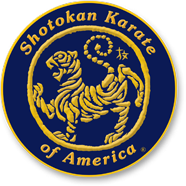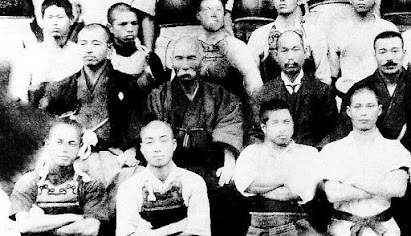Ten Lessons of To-te was written in October, 1908 by Anko Itosu, one of Gichin Funakoshi’s two most influential teachers.
- Anko Itosu (just left of centre sporting a big white moustache), at a martial arts exhibition in 1908.
The following is excerpted from Tales of Okinawa’s Great Masters by Shoshin Nagamine, Translated by Patrick McCarthy.
- Karate does not endeavor only to discipline one’s physique. If and when the necessity arises to fight for a just cause, karate provides the fortitude with which to risk one’s own life in support of that campaign. It is not menat to be employed against a single adversary but rather as a means of avoiding the use of one’s hands and feet in the event of a potentially dangerous encounter with a ruffian or a villain.
- The primary purpose of karate training is to strengthen the muscles, making the physique strong like iron and stone so that one can use the hands and feet to approximate such weapons as a spear or halberd. In doing so, karate training cultivates bravery and valor in children and it should be encouraged in our elementary schools. Don’t forget what the Duke of Wellington said after defeating Emperor Napoleon: “The Battle of Waterloo was won on the playing fields of Eton.”
- Karate cannot be adequately learned in a short period of time. Like a sluggish bull, regardless of how slowly it moves it will eventually cover a thousand miles. So too, for one who resolves to study diligently two or three hours every day, after three or four years of unremitting effort one’s body will undergo a great transformation, revealing the very essence of karate.
- One of the most important issues in karate is the importance of training the hands and the feet. Therefore, one must always make use of the makiwara in order to develop them thoroughly. In order to do this effectively, lower the shoulders, open the lungs, focus your energy, firmly grip the ground to root your posture, and sink your ki, forcing it into your tanden. Following this procedure, perform one to two hundred punches with each hand every day.
- One must maintain an upright position in the training postures of karate. The back should be straight, loins pointing upward with the shoulders down, while maintaining a pliable power in your legs. Relax and bring together the upper and lower parts of the body with the ki force focused in your tanden.
- Handed down by word of mouth, karate is comprised of a myriad of techniques and corresponding meanings. Resolve to independently explore the context of these techniques, observing the principles oftorite (theory of usage), and the practical applications will be more easily understood.
- In karate training one must determine whether the interpretation of a movement is suitable for defense or for cultivating the body.
- Intensity is an important issue in karate training. To visualize the one is actually engaged on the battlefield during training does much to enhance progression. Therefore, the eyes should dispatch fierceness while lowering the shoulders and contracting the body when delivering a blow. Training in this spirit prepares one for actual combat.
- The amount of training must be in proportion to one’s physical reservoir of strength and conditioning. Excessive practice is harmful to one’s body and can be recognized when the face and eyes become red.
- Participants of karate usually enjoy a long and healthy life, thanks to the benefits of unremitting training. Practice strengthens muscle and bone, improves the digestive organs, and regulates blood circulation. Therefore, if the study of karate were introduced into our curricula from elementary school and practiced extensively we could more easily produce men of immeasurable defense capabilities.
With these teachings in mind, it is my conviction that if the students at the Shihan Chugakko (old name of Okinawa’s Teachers College) practice karate they could, after graduation, introduce the discipline at the local levels; namely to elementary schools. In this way karate could be disseminated throughout the entire nation and not only benefit people in general but also serve as an enormous asset to our military forces.

